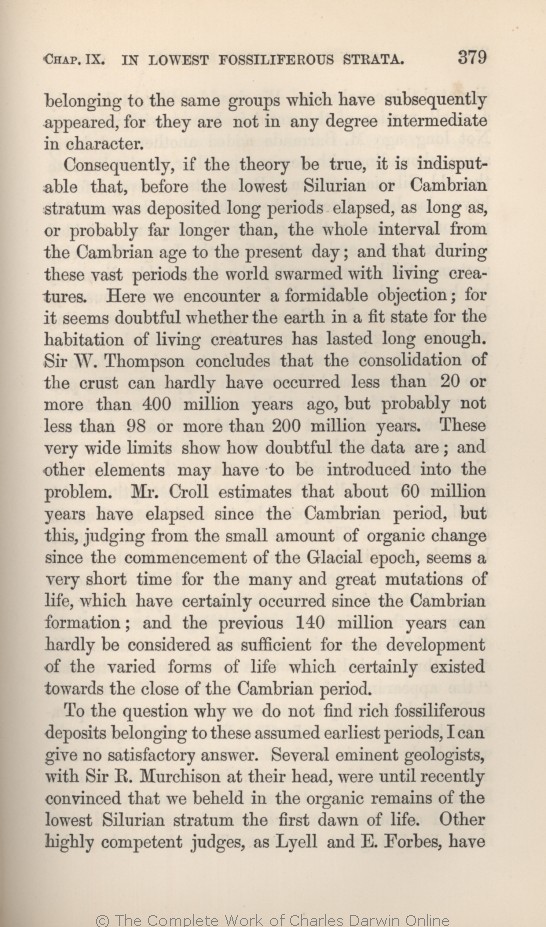belonging to the same groups which have subsequently appeared, | belonging to the same groups which have subsequently appeared, 1869 1872 |
| of the orders to which they belong, 1859 1860 1861 |
| belonging to the same group which have subsequently appeared, 1866 |
| are 1869 1872 | | do 1859 1860 1861 1866 |
| ..... 1869 1872 | | present characters 1859 1860 1861 1866 |
| in character. 1869 1872 | | between them. 1859 1860 1861 1866 |
| 1 blocks not present in 1866 1869 1872; present in 1859 1860 1861 | | If, moreover, they had been the progenitors of these orders, they would almost certainly have been long ago supplanted and exterminated by their numerous and improved descendants.
|
|
|
Consequently, if
the | the 1869 1872 | | my 1859 1860 1861 1866 |
| that, 1866 1869 | | that 1859 1860 1861 1872 |
| Silurian 1859 1860 1861 1866 1869 | | Cambrian 1872 |
| or Cambrian stratum 1869 |
| stratum 1859 1860 1861 1866 1872 |
| deposited 1869 | | deposited, 1859 1860 1861 1866 1872 |
| Cambrian 1869 1872 | | Silurian 1859 1860 1861 1866 |
| vast 1869 1872 | | vast, 1859 1860 1861 1866 |
| periods 1869 1872 |
| yet quite unknown, periods of time, 1859 1860 1861 1866 |
| creatures 1869 | | creatures, 1872 |
| certainly 1869 | | already 1872 |
| close of the 1869 |
| OMIT 1872 |
|
|
To the question why we do not find
rich fossiliferous deposits belonging to these assumed earliest periods, | rich fossiliferous deposits belonging to these assumed earliest periods, 1869 |
| records of these vast primordial periods, 1859 1860 1861 |
| richly fossiliferous records of these vast primordial periods, 1866 |
| rich fossiliferous deposits belonging to these assumed earliest periods prior to the Cambrian system, 1872 |
| OMIT 1866 1869 1872 |
| of the most 1859 1860 1861 |
| were until recently 1866 1869 1872 |
| are 1859 1860 1861 |
| beheld 1866 1869 1872 | | see 1859 1860 1861 |
| first dawn 1866 1869 1872 | | dawn 1859 1860 1861 |
| life. 1869 1872 | | life 1859 1860 1861 1866 |
| ..... 1869 1872 | | on 1859 1860 1861 1866 |
| ..... 1869 1872 | | this 1859 1860 1861 1866 |
| ..... 1869 1872 | | planet. 1859 1860 1861 1866 |
| ..... 1869 1872 | | the late 1859 1860 1861 1866 |
|









